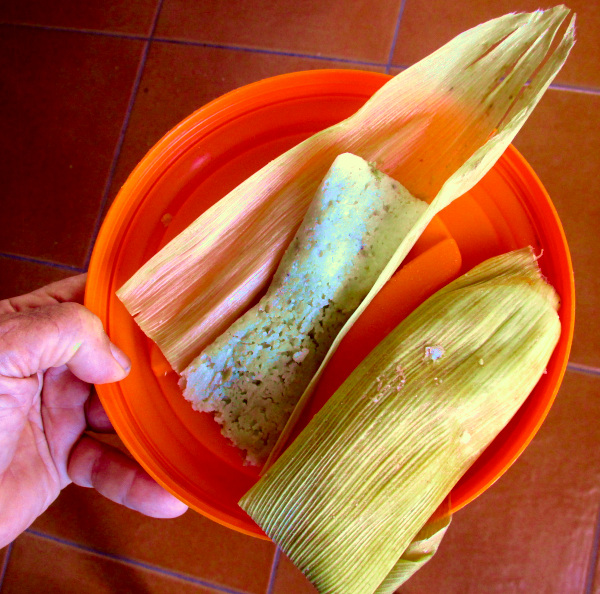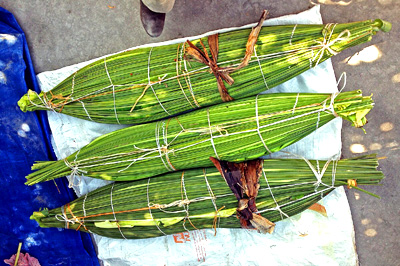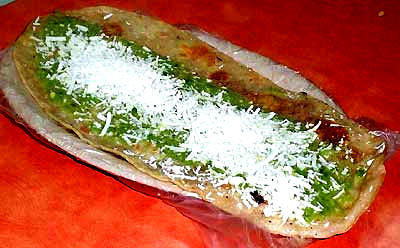 Tortillas baking on a traditional elevated fireplace in Pantepec, Chiapas. The señora makes about 50 tortillas each day. Her mother at the right is blind and in her 90s. Photo by Cherry Bedenkop of Arizona
Tortillas baking on a traditional elevated fireplace in Pantepec, Chiapas. The señora makes about 50 tortillas each day. Her mother at the right is blind and in her 90s. Photo by Cherry Bedenkop of ArizonaCorn, what Europeans call maize and Spanish-speakers refer to as maíz, has always been transcendentally important to Mexican culture. The picture at the right shows an event that takes place thousands of times a day all over Mexico, where corn enables people to survive. In the picture you see a traditional elevated fireplace on which two tortillas are baking over a fire. The white platter on which the tortillas are baking is the cut top off of a barrel. These are indigenous people living in the countryside, but many city folks can't do without their hot tortillas, either.
Remains of the earth's earliest known corn have been excavated in Coxcatlán Cave in southeastern Puebla. Corn appears in the archeological record exactly at the time when ancient Mexicans were emerging from their paleolithic hunting and gathering stage into more complex, sedentary lifestyles based on agriculture. From the beginning, Mexicans and corn have evolved together toward modern times.

6-year-old Kami Kay eating elotes, photo courtesy of Lanita Medina of Maine
The ancient Maya conceived of corn as sacred. It was a kind of friendly god at the Maya farmer's side striving to bring the Maya family prosperity and happiness. Today, corn products are so integral to traditional Mexican cuisine that a whole lexicon has coalesced around it. Here are some "corn words" likely to seen and heard during mercado wanderings:
 Elote, sweetcorn roasted by a sidewalk grill at the Jamaica mercado in Mexico City, doused with limon juice and sprinkled with salt and chili powder; copyright-free image courtesy of "Pequeño mar" made available through Wikimedia Commons.
Elote, sweetcorn roasted by a sidewalk grill at the Jamaica mercado in Mexico City, doused with limon juice and sprinkled with salt and chili powder; copyright-free image courtesy of "Pequeño mar" made available through Wikimedia Commons.Elotes are roasted or boiled ears of sweet corn. Roasted elotes are often prepared on street-side grills and look like what's seen at the left. Boiled elotes typically are fished from tubs of hot water, or cloth-covered buckets, and likewise sold along streets. Roasted elotes may be smeared with butter or mayonnaise, or possibly doused with lemon juice. Salt and powdered chili pepper, or maybe tabasco sauce, may also be sprinkled on. Boiled elotes typically are amply buttered. Both kinds of elote may be impaled on sticks so that the customer can walk down the street nibbling the ear as if it were a drumstick.
Pinole is what results if you roast some mature corn kernels and grind them into a dry powder. Pinole is seldom sold in mercados because the Indians likely to relish it are also likely to make it in their own homes. However, in isolated markets you well might spot Indians nibbling pinole from a bag or bound-up cloth, for it is so lightweight, nutritious, and unlikely to spoil that it is -- and for many centuries has been -- considered "traveling food."
Nixtamal begins life as several handsful of hard, mature corn-kernels, which are soaked overnight in a pot of water and lime, and then cooked. During the soaking process, as the kernels imbibe water, swell and soften, the lime not only causes the kernels' undigestible skin, or seed coat, to slough off, but also it imparts to the corn a high level of calcium, increases the availability of iron to the human body, and liberates niacin for the body's use. Wash the resulting hominylike kernels thoroughly to remove the milky-white lime-water and the rubbery seed coats, which float to the top, and now, with this collection of moist, soft, puffy corn kernels, you have your nixtamal. In mercados, nixtamal is sometimes sold to señoras wanting to forego the time-consuming cooking and washing process, but who still want to use nixtamal in their traditional corn dishes.

Photo by Lanita Medina of Maine
Masa is the moist, cream-colored paste resulting from grinding nixtamal. In the old days grinding was done with stone mortar and pestle -- and in some isolated villages it still is. Nowadays it's more typical for it to be ground with a hand-turned, metal grinder mounted on the side of the table, or else to be carried to special shops, usually in or near the mercado, where large electrically powered grinders do the job. If early in the morning you see a line of women and children with cloth-covered dish pans standing in line along a street, it's a good bet that the dish pans hold nixtamal to be ground into masa. And very many traditional Mexican recipes begin with the words, "First, form your masa into... "
Tortillas are so important in Mexican cuisine that they have their own page.

Tamales like those seen at the left are produced by working some lard into your masa and then forming it into quadrangular, baglike objects maybe 3½ inches (9cm) long. Stuff these masa bags with anything from bean paste to rabbit meat, seal them, wrap them in dry corn shucks or banana leaves, and steam them until the masa and ingredients are cooked. Now you have tamales. Variations on the basic tamale theme abound. The open one in the picture is made of rice with flecks of pork.
For example, in Oaxaca, among the Mazatecs, more than ten different kinds of tamales have been documented. Among the Zapotecs in Choapan, Oaxaca there exists a diminutive tamale called pata de burro, or "burro's foot," named for their untamalelike shape. Usually these are cooked three at a time wrapped together. In Tuxtla Gutiérrez, Chiapas, the juacané tamale, probably of Zoque origin, is stuffed with ground beans, the heads of shrimp, squash seeds, and small, hot chili peppers. In Morelos and Guerrero the tamal nejo is concocted of masa in which the corn has been cooked not in lime-water, but in water in which ashes have settled. Sometimes, instead of steaming tamales, they are roasted among the embers of wood fires; these are called tamales de ceniza, or "ash tamales."
 Big zacahuil tamales in Hidalgo state before being buried and cooked; copyright-free image courtesy of "Elizabethcasasola" made available through Wikimedia Commons.
Big zacahuil tamales in Hidalgo state before being buried and cooked; copyright-free image courtesy of "Elizabethcasasola" made available through Wikimedia Commons.The Huastecs of east-central Mexico make zacahuil, a tamale up to a yard or more long containing anything from a whole suckling pig to a turkey or a chicken. These are seasoned with chilies, onion, and garlic, wrapped in banana leaves or maybe reeds or palm leaves as seen at the right, and cooked slowly in an earthen pit or brick oven. Some tamales are sweet, such as the canarios of Oaxaca, which are made with rice flour, butter, and egg, and filled with egg and sweet condensed milk. The Otomies of the Valle del Mezquital make tamales of ground corn seasoned with brown-sugar syrup, anise, and cinnamon.
Towns sometimes specialize in one or more tamale kind. In Mexico State, tamales containing small slices of nopal cactus are found in Acolmán, while pea tamales are eaten in Amanalco, plantain tamales in Huitzilac, corn ones in Otzolotepec, and, in Temoaya, they put lima beans in their tamales. In Jiutepec, Morelos, you find cherry tamales, while not far away, in Tepoztlán they go for fish ones.
Certain tamales are seen only during specific celebrations. During the All Saints holiday in Tlapa, Guerrero xato tamales are concocted of cornmeal, lard, and unrefined brown sugar. In Morelos, festive tamales called xocotamales are made of blue corn and lima beans; in Cuautitlán, Mexico, festival tamales contain rabbit meat.
 Quesadilla on blue-corn tortilla in Mexico City
Quesadilla on blue-corn tortilla in Mexico CityThere exists a whole world of masa-based Mexican cuisine beyond the tortillas and tamales just mentioned. Fold a tortilla over some bean paste, fry it in oil or grease, and you have a bean taco. If the ingredient is chicken, then you have a chicken taco. If the taco includes cheese, then it's a quesadilla. If you order a quesadilla at a comedor in central Mexico your quesadilla's tortilla may be either yellow or blue, depending on the kind of corn it is made from, and if your quesadilla has the traditional half-moon shape, the curved part might be fancily scalloped; or your quesadilla might even be triangular. These would be considered blasphemous tamale innovations in some areas.
 Huarache from a comedor in Mexico City
Huarache from a comedor in Mexico CityIn most of Mexico the word huarache means "sandal," but in the central Mexican uplands a huarache also is a large, oblong item made of fried masa, often of the blue kind, stuffed with yellowish bean paste, and liberally garnished, as seen at the right. Most Mexicans know that a gordita is made of masa mixed with lard, stuffed with almost any ingredient, and fried in oil or grease, but in certain places in east-central Mexico they make sweet gorditas flavored with cinnamon, and then toasted on a comal over which tiny pebbles collected from around ant nests have been strewn. The pebbles hold the gorditas de hormiguero (ant-hill gorditas) a little above the comal's hot surface, thus cutting down on burning.
We could go on, but by now maybe you get the corn-picture.